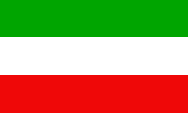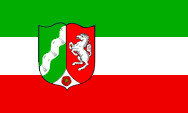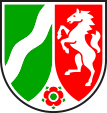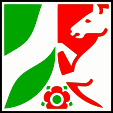Nordrhein-Westfalen |
|
|
|
| Übersicht – Contents: | |
Nordrhein-Westfalen |
|
|
|
| Übersicht – Contents: | |
Flaggen – Flags: |
|
 |
Landesflagge – flag of the country |
 |
Landesdienstflagge – official flag |
|
|
|
Bedeutung/Ursprung der Flagge – Meaning/Origin of the Flag: |
|
| Flagge und Wappen von Nordrhein-Westfalen wurden im Jahre 1948 eingeführt und 1953 per Gesetz bestätigt. Die Flagge stellt eine Kombination aus den Farben der preußischen Provinzen Rheinland (grün-weiß) und Westfalen (weiß-rot) dar. Das Wappen zeigt die heraldischen Symbole für die Landesteile Rheinland (weiße Wellenlinie auf grünem Grund), Westfalen (weißes Pferd auf rotem Grund) und Lippe-Detmold (rote Rose auf weißem Grund). | The flag and the coat of arms of North Rhine-Westphalia were introduced in 1948 and confirmed in 1953. In her assembly of the colours is the flag a combination of the colours of the prussian provinces Rhineland (green-white) and Westfalia (white-red). The coat of arms shows the heraldic symbols for the country-parts Rhineland (white wave-line on green ground), Westfalia (white horse on red ground) and Lippe-Detmold (red rose on white ground). |
| In den 1920-er Jahren verwendeten bereits die rheinischen Separatisten die gleiche Flagge (ohne Wappen!). | In the twenties of the 20th century Rhinanian separatists already used the same flag. (without the coat of arms!) |
| Quelle/Source: Die Welt der Flaggen, Volker Preuß | |
Wappen – Coat of Arms: |
|
 |
Wappen von Nordrhein-Westfalen – coat of arms of North Rhine-Westphalia, Quelle/Source: Corel Draw 4 |
 |
seit/since 2007, vereinfachtes Wappen – stylized coat of arms, Quelle/Source: www.land.nrw |
 |
seit/since 2009, Nordrhein-Westfalen-Zeichen – North Rhine-Westphalia Sign, Quelle/Source: www.land.nrw |
|
|
|
Bedeutung/Ursprung des Wappens – Meaning/Origin of the Coat of Arms: |
|||||
| Das Wappen von Nordrhein-Westfalen wurde im Jahre 1948 eingeführt und 1953 per Gesetz bestätigt. Das Wappen zeigt die heraldischen Symbole für die Landesteile Rheinland (weiße Wellenlinie auf grünem Grund), Westfalen (weißes Pferd auf rotem Grund) und Lippe-Detmold (rote Rose auf weißem Grund). | The coat of arms of North Rhine-Westphalia was introduced in 1948 and confirmed in 1953. The coat of arms shows the heraldic symbols for the country-parts Rhineland (white wave-line on green ground), Westfalia (white horse on red ground) and Lippe-Detmold (red rose on white ground). | ||||
| Das weiße
Pferd im Wappen ist das "Westfalenpferd". Es geht als "Sachsenross" auf das Stammesherzogtum
Sachsen zurück, und wurde von den Welfen übernommen, deren Symbol eigentlich
ein goldener Löwe auf rotem Grund war. So wurde es zum Wappentier des
Königreichs Hannover (ab 1866 preußische Provinz Hannover), der preußischen
Provinz Westfalen und ab 1922 des Landes Braunschweig. In der BRD wird diese Tradition fortgesetzt, in dem jene Bundesländer der BRD, zu denen ehemals welfische Gebiete gehören, noch heute das weiße Pferd im Wappen haben: Niedersachsen und Nordrhein-Westfalen. |
The white horse in the coat of arms is the "Westfalia Horse". It has its roots as "Saxons Ross" in the Tribal-Duchy of Saxony and was later adoped from the Welfen-Dynasty. Their symbol was actually a golden lion on red ground. In this way became it the heraldic animal of the Kingdom of Hannover (since 1866 Prussian Province of Hannover), of the Prussian Province of Westfalia and since 1922 of the Country of Brunswick. This tradition is continued in the FRG at those federal countries to which formerly Welfian territories belong. In this way they have until today the white horse in their coats of arms: Lower Saxony and North Rhine-Westphalia. | ||||
| Quelle/Source: Die Welt der Flaggen, Volker Preuß | |||||
| "Das Wappen des Landes Nordrhein-Westfalen besteht aus Rhein, Ross und Rose und ist in den Farben Grün, Weiß und Rot gehalten. Neben dem Landeswappen gibt es auch ein so genanntes Nordrhein-Westfalen-Zeichen. Im Gegensatz zu den amtlichen Wappen kann dieses von Jedermann verwendet werden. " ¹ |
"The coat of arms of the state of North Rhine-Westphalia shows the Rhine River, Ross and Rose and is coloured in green, white and red. In addition to the national coat of arms, there is also a so-called North Rhine-Westphalia Sign. Unlike the official coat of arms, this can be used by anyone." ¹
|
Quelle/Source: ¹
www.land.nrw |
|
| ||
Landkarte – Map: |
| Die BRD und ihre Länder, interaktive Karte
– FRG and its countries, clickable map: |
|
Zahlen und Fakten – Numbers and Facts: |
|
|
|
|
|
|
|
|
|
|
|
|
Geschichte: |
| Das Land Nordrhein-Westfalen wurde am 01.08.1946 auf Beschluss der Alliierten aus der preußischen Provinz Westfalen, dem Norden der preußischen Rheinprovinz und dem Land Lippe-Detmold gebildet. |
History: |
| The country North Rhine-Westphalia was formed on 1st of August in 1947 by order of the allied from the Prussian Province of Westfalia, the northern part of the Prussian Rhine Province and the country Lippe-Detmold. |
| Quelle/Source: Wikipedia (D) |